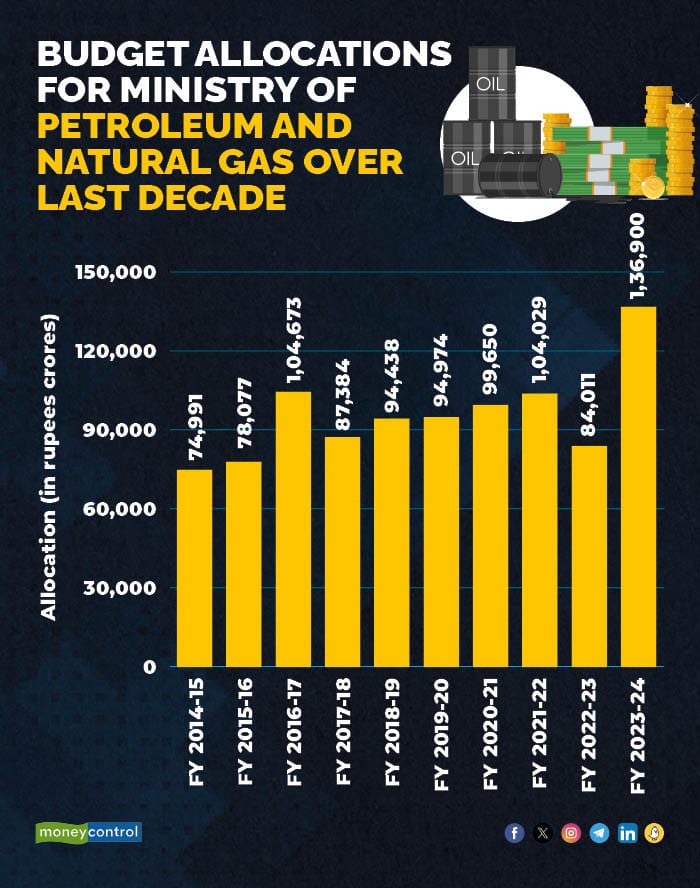



India’s oil and gas sector has witnessed several milestone changes in the past 10 years, ranging from increasing exploration to inching towards net zero emissions.
The government has pushed to expand oil and gas exploration in the past decade to achieve a greater level of energy self-reliance by opening up “no-go areas” for exploration. The objective is to reduce dependence on imports for the majority of its energy needs.
The government is also focused on the energy transition of the oil and gas industry as India aims to achieve net zero emissions by 2070. Companies in the oil and gas sector, one of the highest contributors to emissions, have already set net-zero targets ahead of 2070.
In the Union Budget for FY24, Finance Minister Nirmala Sitharaman allocated Rs 35,000 crore for capital investments towards energy transition and net zero emission objectives for state-run oil marketing companies (OMCs). However, the amount has not been allocated to the OMCs.

The Big Hits
LPG connections: A record 170 million new cooking gas connections were granted in the past decade under the Modi government, taking the total to 312.6 million. Of them, 95.8 million connections were released under the Pradhan Mantri Ujjwala Yojana, an initiative to provide free cooking gas to poor households.
Increase in exploration: The Modi government increased exploration to reduce the country’s reliance on oil imports. It opened up “no-go areas” such as the Andaman and Nicobar Islands for exploration to boost domestic oil production.
Ethanol blending: Ethanol blending in petrol has reached levels of 12 percent from 5 percent in 2014. The government aims to roll out 20 percent blending by 2025, five years ahead of its earlier target.
City gas infrastructure: In India, domestic piped natural gas connections increased fourfold to 10.4 million from 2.54 million in 2014. With the latest 12th city gas distribution (CGD) bidding round, the entire country will have access to CGD networks. From 66 districts in 2014, the CGD network now covers 630 districts.
Kirit Parikh recommendations: To liberalise domestic natural gas prices, the government-linked them to the cost of imported crude. They would be 10 percent of the monthly average of the Indian crude oil basket, subject to a floor and ceiling of $4 per mmBtu and $6.5 per mmBtu, respectively.
The Big Misses
Petrol/diesel outside GST: Despite industry urgings, the government has not brought petroleum products under the goods and services tax. Currently, fuels such as petrol, diesel, natural gas and aviation turbine fuel are not under GST.
Increase in oil imports: With the growth of oil consumption in India, imports of crude oil increased despite the government’s efforts to boost domestic production. India imports 87 percent of its crude oil requirements.
Low natural gas share: India is focused on becoming a gas-based economy, but the share of natural gas in the energy basket remains low, at about 6.2 percent. This comes amid lower domestic production of natural gas and reliance of power plants on coal in India.
Expert Speak
Suman Chowdhury, chief economist & head of research, Acuite Ratings & Research
One of the key policy measures in the last nine years has been the notification of the National Policy on Bio Fuels in 2018, which has been further amended in 2022. The policy primarily incentivises the production of ethanol not only from sugarcane but also from food grain waste and other agro-commodities. The country has already achieved 12 percent ethanol blending with petrol in the current fiscal and has advanced the target of 20 percent to FY26 instead of FY30. This will reduce the import dependence of crude oil to a moderate extent.
Prashant Vasisht, senior vice president and co-head, corporate ratings, ICRA
Some of the key issues hindering the development of the upstream sector include a high cess of 20 percent ad-valorem currently, a slow pace of approvals, and progress in several blocks stalled because of the absence of requisite approvals from the Ministry of Defence and/or the Ministry of Environment, Forest and Climate Change, delays in decision-making by the DGH (Directorate General of Hydrocarbons), increasing arbitration cases involving the administration of production-sharing contracts, etc.
Sourav Mitra, practice leader & director – consulting, CRISIL Market Intelligence and Analytics
The Indian oil and gas industry is on the right trajectory and will complement GDP growth. The biggest changes that will come into play in the industry in the next five years would be: i) Increased share of biofuels in the O&G mix, ii) With the expanding pipeline and CGD network, increased access to natural gas to consumers across the country and, iii) Introduction of carbon markets in the system as more and more O&G companies declare their net-zero targets.
Discover the latest Business News, Sensex, and Nifty updates. Obtain Personal Finance insights, tax queries, and expert opinions on Moneycontrol or download the Moneycontrol App to stay updated!
Find the best of Al News in one place, specially curated for you every weekend.
Stay on top of the latest tech trends and biggest startup news.